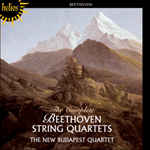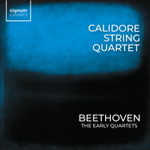
Welcome to Hyperion Records, a British classical label devoted to presenting high-quality recordings of music of all styles and from all periods from the twelfth century to the twenty-first.
Hyperion offers both CDs, and downloads in a number of formats. The site is also available in several languages.
Please use the dropdown buttons to set your preferred options, or use the checkbox to accept the defaults.

| Calidore String Quartet» More |
Beethoven's first movement starts with a delightful exchange of phrases that deceptively adopts eighteenth-century manners. But we must take care about this — the second phrase turns up again in the Scherzo of the late C sharp minor Quartet. As we shall see, Beethoven was able throughout his life to use the simplest material to the profoundest ends. In this case any profundity lies in the subtlety with which he is able to manipulate light-textured matter — perhaps we are apt to forget that a mosquito has unfathomable such profundities! Be that as it may, Beethoven does not altogether eschew emotionally deeper suggestions, as in the pianissimo change to E flat in the development, with a mysterious fugato; but it is abruptly dismissed, and the movement resumes its witty course, Coming soon to an astonishingly concentrated yet broad approach to the recapitulation.
The C major Adagio is plain sailing, if one can so describe the concertante decorations of the first violin, joined by the cello in the reprise. Harmonically it avoids 'expression' like the plague. The plainness recalls the Haydn slow finale already mentioned, not least because Haydn also interrupts his slow music with a presto that sounds like another movement, the interruption suggesting the slow movement to have been a protracted introduction to a quick finale which, however, quickly evaporates, leaving the Adagio in full possession to the end. In the second movement of a four-movement Quartet, Beethoven makes his quick section pose as the premature arrival of a scherzo, and in returning to the slow music he does not aspire to the immense gravity of Haydn. Perhaps Beethoven's light-hearted, even sardonic allusion slightly misfires if we draw too close a parallel, and so long as we are not expecting a deep slow movement (of which we know Beethoven to be capable even in his early period) we can accept this piece as an easy going relaxation during a comedy.
The real Scherzo is brilliantly unpredictable, thematically and harmonically, with a C major trio employing sparkling triplets, from which a link leads back to the return. Beethoven's early scherzos show amazing variety and resource, the answer to Haydn's wistful 'I wish someone would show us a new way to write minuets'. Some of them would not surprise us in much later works.
Beethoven's Finale shows what he has learnt from Haydn, who would greatly have admired what it makes of manifold witty inversions and diminutions of its first three notes. This vividly humorous movement also shows what can be done by constant flexibility in contrasting textures and phrase-lengths in music that nothing can hinder as it hurtles by. In the Finale of the G major String Trio, op 9 no 1, we find Beethoven using groups of three notes with astonishing resource, and although at least one of its themes could easily have occurred in the Quartet, he does not repeat a single device from the earlier work.
from notes by Robert Simpson © 1990
Chez Beethoven, le premier mouvement commence par un délicieux échange de phrases aux fausses allures dix-huitième. Mais il est intéressant de noter que la seconde phrase réapparaîtra plus tard dans le scherzo du quatuor en do dièse mineur. Comme nous le verrons, Beethoven a toujours su employer les éléments les plus simples avec la plus grande richesse. Ici, la profondeur est dans la subtilité avec laquelle il parvient à employer un sujet aussi peu étoffé — peut-être sommes-nous capables d'oublier qu'un moustique a des profondeurs tout aussi insondables! Quoi qu'il en soit, Beethoven ne s'abstient pas totalement de suggérer des émotions plus profondes comme avec la modulation pianissimo en mi bémol du mystérieux fugato dans le développement; mais il est abruptement interrompu et le mouvement reprend son course spirituel pour arriver bientôt à une approche à la fois étonnamment concentrée et large de la récapitulation.
L'adagio en do majeur marche toutes voiles dehors si l'on peut ainsi décrire les arabesques concertantes du premier violon que le violoncelle rejoint à la reprise. Au plan harmonique, il évite 'l'expression' comme la peste. Par sa clarté, il rappelle le finale lent de Haydn mentionné auquel il ressemble surtout parce que Haydn interrompt également le mouvement lent par un presto qui sonne comme un nouveau mouvement, interruption qui fait ressembler le movement lent à l'introduction prolongée d'un finale rapide qui, toutefois, disparaît rapidement pour faire place à l'adagio jusqu'à la fin. Dans le second mouvement d'un quatuor en quatre mouvements, Beethoven traite la partie rapide comme un scherzo prémature et, revenant au mouvement lent, il ne recherche pas l'immense gravité de Haydn. Peut-être la joyeuse allusion de Beethoven échoue-t-elle un peu quand nous poussons le parallèle trop loin et, si nous n'attendons pas particulièrement de profondeur du mouvement lent (ce dont nous savons Beethoven capable même à ses débuts), nous pouvons considérer cette pièce comme le petit intermède d'une comédie.
Le vrai Scherzo est superbement imprévisible à la fois au plan thématique et au plan harmonique, avec un Trio en do majeur aux étincelants triolets qui, d'une envolée, enchaînent sur la suite. Par leur incroyable diversité et leur nouveauté, les premiers scherzos de Beethoven réalisent le voeu mélancolique exprimé par Haydn: "J'aimerais que quelqu'un nous montre une nouvelle manière d'écrire des menuets". Certains d'entre eux ne nous surprendraient pas dans des oeuvres bien plus tardives. Dans le Finale, Beethoven montre ce qu'il a appris de Haydn qui aurait beaucoup admiré les ingénieuses inversions et diminutions de ses trois premières notes. Ce mouvement plein de vie et d'humour est aussi le fruit d'une constante souplesse dans les contrastes de matière et de longueurs de phrases d'une musique dont rien n'entrave le cours.
Dans le Finale du Trio en sol majeur, op 9 no 1, Beethoven emploie des groupes de trois notes avec une étonnante habileté; l'un au moins de ses thèmes aurait pu réapparaître dans le quatuor mais il ne répète aucun des procédés de l'oeuvre précédente.
extrait des notes rédigées par Robert Simpson © 1990
Français: Jacqueline Letteron
Beethovens erster Satz beginnt mit einem freudigen Wechsel von Phrasen, welche zum Verwechseln ähnlich die Kompositionsweise des 18. Jahrhunderts wiedergeben. Die zweite Phrase kommt beachtenswerterweise im Scherzo des späteren Quartetts in Cis-Moll wieder vor. Zeitlebens war Beethoven im Stande tiefgreifende Finali aus einfachsten Materialien zu komponieren. In diesem Fall liegt die Tiefgründigkeit im sanften Umgang mit dem zartgewobenen Hauptthema. Wie so oft meidet Beethoven durchaus nicht tief-emotionale Passagen, wie etwas hier, wo er das Pianissimo zu einem geheimnisvollen Fugato in Es-Dur hinüberwechseln lässt. Doch abrupt abgelöst, nimmt der Satz seinen witzigen Charakter wieder an, und mündet in der Folge in eine erstaunlich konzentrierte Reprise.
Das Adagio in C-Dur gleitet sanft dahin, wenn man die melodiösen Ausschmückungen der ersten Geige — in den Wiederholungen vom Cello begleitet — so umschreiben möchte. Hinsichtlich der Harmonie werden jegliche Konturen geflissentlich vermieden. Die Schlichtheit errinnert an das bereits erwähnte langsame Finale von Haydn, nicht zuletzt deshalb, weil auch dieser seine ruhige Musik mit einem Presto, das sich wie ein eigener Satz ausmacht, unterbricht. Gegen Ende des Satzes greift das Adagio wieder voll Platz, die Unterbrechung verdeutlicht aber, dass dieser langsame Satz eine ausladende Einleitung eines schnellen Finales ist. Im zweiten der vier Sätze des Quartetts zeigt Beethoven durch ein vorgezogenes Scherzo seinen Liebe für schnelle Abschnitte. Nachdem er wieder zum ruhigen musikalischen Fluss zurückgefunden hat, legt er jedoch nicht mehr den Schwerpunkt auf jene immensen Ernsthaftigkeit, wie Haydn. Freilich versagt Beethovens heitere, ja sogar ironische Anspielung auf Haydn dann, wenn man zu genaue Parallelen erkennen möchte. Solange man keinen tiefen, langsamen Satz erwartet (zu dem Beethoven auch in seinen frühen Jahren fähig war), kann man diesen Teil als eine entspannende Lockerung einer Komödie auffassen.
Das richtige Scherzo ist sowohl thematisch als auch harmonisch ausserordenlich kurzweilig, mit einem Trio in C-Dur, das von heiterem Triolenspiel lebt, das sich nach einer Überleitung wiederholt. Beethovens frühestes Scherzo ist von grüsster Schöpfungskraft, die Antwort auf Haydn's nachdenklichen Ausspruch: 'Ich wünschte, jemand würde uns eine neue Art und Weise zeigen, wie man Menuette schreibt'.
Das Finale lässt darauf schliessen, dass Beethoven von Haydn gelernt hatte. Haydn wiederum hätte Wunder genommen daran, wie mannigfaltig-witzige Umkehrungen und Verminderungen der ersten drei Noten sich auswirken können. Ein kontrastreiches, geschmeidiges Gefüge und die unterschiedliche Länge und Beschaffenheit der Phrasen, beleben diesen unaufhaltsam fliessenden und humorvollen Satz. Im Finale des Streicher-trios in G-Dur, Op 9 Nr. 1, sehen wir wie Beethoven Gruppen von je drei Noten mit erstaunlicher Findigkeit variiert, was erwarten lässt, dass zumindest ein Thema daraus, in einem dieser Quartette wieder vorkommt. Er wiederholt jedoch nicht ein einziges Muster aus seinen früheren Werken.
aus dem Begleittext von Robert Simpson © 1990
Deutsch: Stefan Kapelar
 Beethoven: String Quartets Beethoven: String Quartets‘Fine performances, always intelligent, with many considerable insights … perfect intonation and excellent ensemble and tonal blend, with first-c ... ‘Very fine … I enjoyed these performances because they deliver Beethoven as I want him, free of the biographical sensationalism. Highly recommend ...» More |
 Beethoven: The early quartets Beethoven: The early quartetsThe string quartet was perhaps the most prestigious (and certainly the most lucrative) genre for a composer at the turn of the nineteenth century. Beethoven left nothing to chance with his inaugural Op 18 set, and they were a triumph, here perform ...» More |

